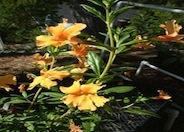
Common name:Sticky Monkey Flower
Botanical name:Mimulus aurantiacus
Sticky Monkey Flower is a drought tolerant evergreen shrub 4 ft. ft tall with numerous orangish/yellow flowers in spring and summer. It is a California native that attracts hummingbirds. This shrub can be found on the dry hills and canyon slopes in the Sierra Nevada foothills and the central Coast Ranges.
-Cornflower Farms
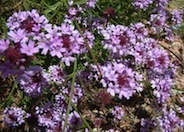
Common name:Cedros Island Verbena
Botanical name:Verbena lilacina 'De La Mina'
Verbena lilacina 'De La Mina' is a selection introduced by the Santa Barbara Botanical Garden. It follows the same wonderful characteristics described under the general species V. lilacina.
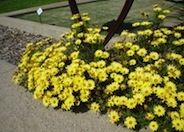
Common name:Arctotis Daisy, African Daisy
Botanical name:Arctotis hybrids
African Daisy hybrids grow 12-18" high x 12" wide and produce daisy-like flowers from spring through summer. These hybrids have lobed leaves and bloom in whtie, pink, red, purple, cream and orange. For trailing African Daisies, see Osteospermum fruticosum, or 'Freeway Daisy'.
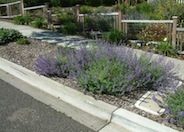
Common name:Catmint
Botanical name:Nepeta X faassenii
Nepeta faassenii makes soft, gray-green, undulating mounds o 1.5 ft. high in bloom. The small leaves are attractive to cats. This perennial has lavender blue flowers in late spring, and early summer.
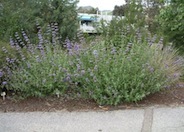
Common name:Purple Sage
Botanical name:Salvia leucophylla
The purple sage is an evergreen shrub that grows 2-3' tall by 5-6' wide. It has white tomentose stems and leaves and light purple flowers that bloom between May and June. This shrub tolerates heat and drought. The purple sage is a California native. -Cornflower Farms
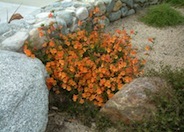
Common name:Pumpkin Monkey Flower
Botanical name:Mimulus 'Pumpkin'
Mimulus 'Pumpkin' is one of the best performing and 'garden tolerant' of the dry Mimulus species/hybrids. Although it still requires well drained soil and drier conditions, in most environments it stays evergreen and can bloom through the year with supplemental summer water when other varieties will die. Reaches 18-24"H x 18-24"W and blooms profusely with two toned pumpkin orange flowers. Truly stunning and effective in the garden, especially in mass.
More than half of the water used at your home is for outside purposes. Studies show that on average, half of the water used outdoors is wasted. The leading cause of waste is incorrectly set and poorly managed irrigation controllers. The second biggest cause of wastage is broken irrigation equipment that goes undetected. There are a few basic things you can do to make a big difference in your water use.
Click in the green box for more information
Designer: Nancy Niemeyer
Photographer: GardenSoft
Physical weed control, including mulching, or hand removal protects the watershed from harmful chemicals.
Mulching and adding compost to soil can minimize evaporation and help soil absorb and store water.
Remove irrigation water and fertilizer from areas where you don't want weeds to grow.